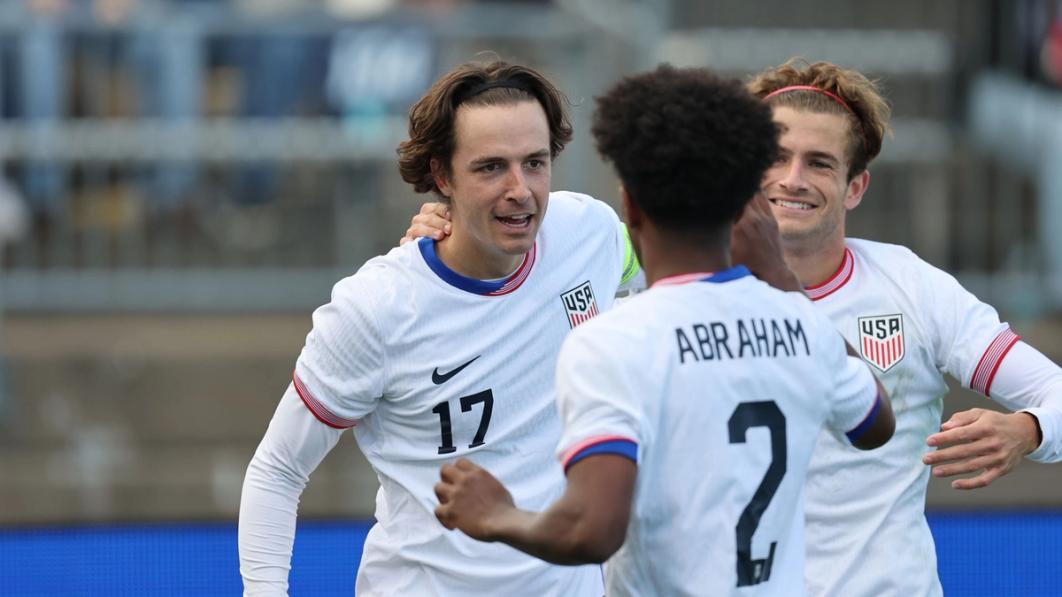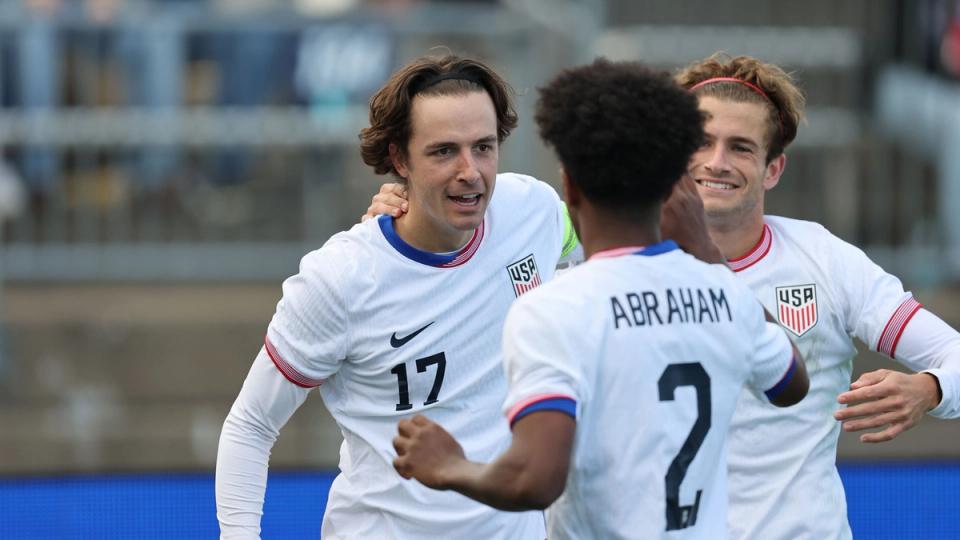Everett Palache Names Final U.S. Men’s Deaf National Team Roster for 2025 Deaflympics in Tokyo
Deaf MNT Will Face Senegal and Ukraine in Group D Play Next Month in Japan



ATLANTA (Nov. 4, 2025) – U.S. Men’s Deaf National Team head coach Everett Palache has named the final roster of players that will represent the United States in the Men’s Football Tournament at the 2025 Deaflympics from Nov. 12-25 in Tokyo, Japan.
Drawn into Group D, the Deaf MNT will face Ukraine on Nov. 16 and Senegal on Nov. 18, with both matches scheduled to kick off at 2:30 a.m. ET (4:30 p.m. local time) in Fukushima, Japan. The top two teams in each group will advance to the quarterfinals.
"We are thrilled to represent the United States at the historic 2025 Deaflympics in Tokyo,” Palache said. “Our roster, which blends experienced veterans with exciting young talent, has been rigorously tested this cycle. The team's bronze medal finish at last year’s Deaf Pan American Games and our friendly win against Germany last month have set us up well for Japan where we are prepared to compete for the podium and determined to bring well-deserved, global exposure to our Deaf National Teams."
Palache has selected 17 players that helped the USA claim bronze at the 2024 Deaf Pan American Games, including a strong veteran core in defenders Kevin Fitzpatrick (Hopatcong, N.J.) and Tate Lancaster (Overland Park, Kan.), midfielders JP Kanashiro (Springfield, Va.) and Raul Silva (San Diego, Calif.) and forward Michael Schmid (Oberlin, Oio). Emergent talent like attackers Samson Abraham (Seattle, Wash.) and Chris Bourdon (San Diego, Calif.), and goalkeeper Sam Lang (Fort Thomas, Ky.) balance out a roster that heads to Japan seeking its first-ever Deaflympics medal.
The Deaf MNT’s participation in the Deaflympics reflects the Federation’s commitment to the U.S. Way, by investing in resources, infrastructure, and comprehensive support for the Extended National Teams, including the Deaf National Teams, to ensure they are fully prepared to compete and succeed on the world stage.
GOALKEEPERS (3): Sam Lang*^ (Fort Thomas, Ky.; 1/0), Andrew Lenert (Long Beach, Calif.; 0/0), Ethan Sullivan (Laguna Niguel, Calif.; 1/0),
DEFENDERS (8): Aidan Burns^ (Cornwall, N.Y.; 7/0), Philip Cruz (St. Augustine, Fla.; 2/0), Kevin Fitzpatrick*^ (Hopatcong, N.J.; 23/0), Luke Haubruge*^ (San Marcos, Calif.; 3/0), Tate Lancaster*^ (Overland Park, Kan.; 15/2), Kevin Oladimeji^ (Washington, D.C.; 2/0), Eddie Perry*^ (Dellwood, Minn.; 24/0), JJ Waterman^ (Altoona, Iowa; 4/0)
MIDFIELDERS (5): Braden Anderson*^ (Boise, Idaho; 21/2), Dawson Anderson*^ (Boise, Idaho; 14/1), JP Kanashiro*^ (Springfield, Va.; 38/2), Joseph Kennedy Jr. (Philadelphia, Pa.; 2/0), Raul Silva*^ (San Diego, Calif.; 30/4)
FORWARDS (6): Samson Abraham^ (Seattle, Wash.; 5/1), Chris Bourdon*^ (San Diego, Calif.; 12/2), Jacob Contreras (Tucson, Ariz; 0/0), Daniel De Moura^ (Holliston, Mass.; 3/0), Bennett Haas^ (Sewickley, Pa.; 5/1), Michael Schmid*^ (Oberlin, Ohio; 30/13)
^Part of squad at 2024 Deaf Pan American Games
* Part of squad at 2023 DIFA World Deaf Football Championships
In its “send-off” match ahead of the 2025 Deaflympics this November, the U.S. Men’s Deaf National Team decisively defeated Germany 3-1 on Oct. 26 in East Hartford, Conn. As part of an historic doubleheader with the U.S. Women’s National Team, the match was broadcast live on truTV, HBO Max and Telemundo Deportes Ahora, and the win was the first for the United States against Germany in six all time meetings since the series began in 2012. Goals from Samson Abraham, Michael Schmid and Tate Lancaster, along with a pair of assists from Chris Bourdon led the attack. Meantime, an aggressive and stodgy U.S. defense was backstopped by 18-year-old goalkeeper Sam Lang, who made four saves in his international debut.
The Deaf MNT qualified for next month’s Deaflympics by virtue of finishing third at the 2024 Deaf Pan American Games in Canoas, Brazil. After drawing 0-0 with Argentina in the group stage, the USA went toe-to-toe with Brazil, drawing the hosts 2-2 behind goals from brothers Braden and Dawson Anderson, but ultimately fell 6-5 on penalty kicks. The team rallied in the Bronze Medal Match, getting a brace from Michael Schmid and goals from Bennett Haas and Tommy Salvi to defeat Mexico 4-0, as well as qualify for this year’s Deaflympics and the 2027 DIFA World Deaf Football Championships in Sydney, Australia.
The history of the U.S. Men’s Deaf National Team dates back to 1965 when the side played its first matches at that year’s Deaflympics in Washington, D.C. The Deaf MNT participated in international competition under U.S. Soccer Federation member association USA Deaf Soccer Association until 2022 when, along with the Deaf Women’s National Team and Power Soccer National Team, they became fully-funded programs under Federation’s Extended National Teams.
The Deaf MNT has taken part in eight previous Deaflympics, as well as four DIFA World Deaf Football Championship tournaments and three editions of the Deaf Pan American Games.
The team’s top achievement came at the 2008 World Championships, where the side advanced to the semifinals before falling on penalty kicks to Turkiÿe and ultimately claiming fourth place.
Out of the five disciplines that make up U.S. Soccer’s ENT programming, Deaf Soccer holds the closest resemblance to the standard game, with only two main rules that differentiate it. First, the sport is contested by Deaf and hard-of-hearing athletes, with qualifying players needing to have a hearing loss of at least 55 decibels in their “better ear.” All players competing in Deaf matches must remove all hearing aids before playing.
Secondly, referees have a flag which they raise along with blowing their whistle to provide a visual cue for players to know when play has stopped. Aside from those two adaptations, Deaf Soccer follows the standard 11-a-side Laws of the Game governed by the International Football Association Board.
The U.S. Way is a shared philosophy, a strategy and a practical toolkit to enable excellence at every level of the game and for us to win. The U.S. Way is intended to work in partnership between the club and National Team environment to cultivate the next generation of talent with three areas of focus: World Class Development Pathways and Environments, including scaled Talent Identification, expanded Youth National Team programming and accelerated development and foundation building across the Extended National Teams; Shared and Scaled Infrastructure, highlighted by the Arthur M. Blank U.S. Soccer National Training Center, U.S. Way digital platform and unified youth calendar; and Professional Development for the Entire Ecosystem, featuring formal courses, technical and administrative staff community building, leadership development, and best practice resource sharing. For more information, visit ussoccer.com/ourvision/us-way.
Founded in 1913, U.S. Soccer has been the official governing body of the sport in the United States for more than 100 years. As U.S. Soccer looks toward the future amid an unprecedented moment of opportunity, it has aligned its efforts around five strategic pillars: Grow the game by increasing youth and adult participation and accessibility to the sport; Foster best playing environments through quality of referees and coaches, and commitment to participant safety; Develop winning teams through solidified pathways and success of professional leagues; Grow the soccer economy to fuel reinvestment by increasing membership, fandom and commercial success; and Create a world-class organization through revitalized structure and culture, best-in-class talent, progress in DEIB, and more. For more information, visit ussoccer.com/ourvision.